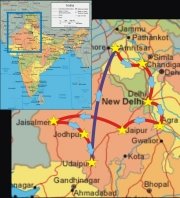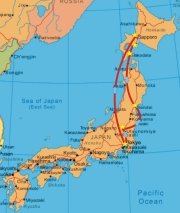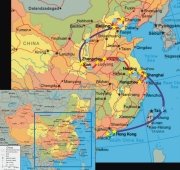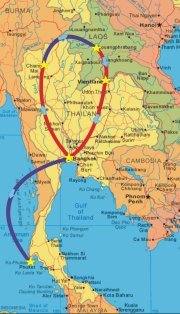OK, that’s a little unfair – it’s a very nice, high class building site, with lots of modern, swish, gleaming buildings between the areas of construction work. And a really nice new airport to greet travellers. Overall, a big improvement on the Beijing we saw just over a year ago. But you get the distinct impression that work to give the city a sparkling image for the summer games is still very much ongoing.
I suppose this must be what happened in Athens a few years back, as I’ve heard that the Olympics caused the city to be transformed (although I’ve only ever seen the gloomy polluted old Athens). And it would be good if London is spruced up a bit for it’s Olympics in a few years time – it certainly could do with a good facelift. Beijing has a few advantages over London too, - after all, the UK has many nice historical sites and attractions, but it certainly does not have anything quite as magnificent as the Great Wall of China to entertain the visitors that come for the Games. On the other hand, London is a smidge less polluted than Beijing, so they’ll have a little less hassle getting the air clean for all the athletes.
We’ve spent most of our time wandering around Beijing so far, visiting various beautiful parks, the main shopping district (Wangfujing street), and of course the Forbidden City. Beijing is pretty large, with everything spaced out, so I suppose you might expect the Imperial Palace to be big, but nothing really prepares you for the scale of the place. Assuming the map in the rough guide is vaguely accurate, the complex is about 1 km wide and 2 km long – and the entire area is packed with buildings and courtyards – very little is given over to gardens. Walking through the length of the place seems to take forever, and that’s without exploring all the tiers of halls and gardens that lie to the East and West of the main palace buildings! If you climb the hill in the Jingshan gardens just to the north of the Forbidden city you get a really good view of the extent of the complex – a mass of glittering intricate yellow ceramic roves that stretches into the distance, the most southerly gates almost disappearing into the haze of the city. Have a look at the photos for some sort of an idea.
Well, I suppose you might expect a place like the Forbidden City to be built for the Chinese Emperors – afterall, apparently they very rarely left it, and enjoyed unbelievably opulent and extravagant lives within. This of course would have encouraged invasion, and as a result there have been a fair few Dynasties. And of course various attempts were made by Emperors to preserve their Empire from marauding heathens – the most ambitious being the Great Wall of China. This incredible (and totally futile) structure stretches from Shahaiguan by the Yellow Sea to the Jiayuguan Pass in the Gobi Desert, and is about 7 meters high and 7 meters wide for its entire length apparently. They do things on a fairly grand scale in China.
We saw the part of the wall that is most accessible from Beijing, and therefore also the most touristy bit. Saying that, getting the 70 km northwest of the city on Chinese public buses (where no-one speaks English, and all place names are only spelt in Chinese symbols on bus stops) was pretty challenging! We plan to be even more adventurous soon and use public transport to visit a quieter, more remote section of wall. Anyway, despite being one of the biggest tourist destinations on Earth, the Badaling section of the Great Wall was utterly magnificent. OK, you do get the hordes of Chinese tourists - mostly in Guided groups with 30 or so middle-aged people wearing identical red baseball hats follow a little red flag around! But actually the vast majority of these only visit the very middle of the Badaling section of wall. If you walk along the wall to the North or the South you easily get away from the crowds. The best bit is the scenery though – this section of wall is built along the top of mountain ridges, so if constantly rises and falls, twisting and turning to follow the highest and therefore most defensible line – almost doubling back on itself at times. It looks almost serpentine as it runs on and on into the distance.
Anyway, we’re leaving Beijing tomorrow to take the train up to Chengde. This is where some of the Emperors came in the summer to escape the heat of Beijing – so you can expect a few more pictures of opulent palaces and gardens to appear on the blog in a few days time!














.JPG)






























